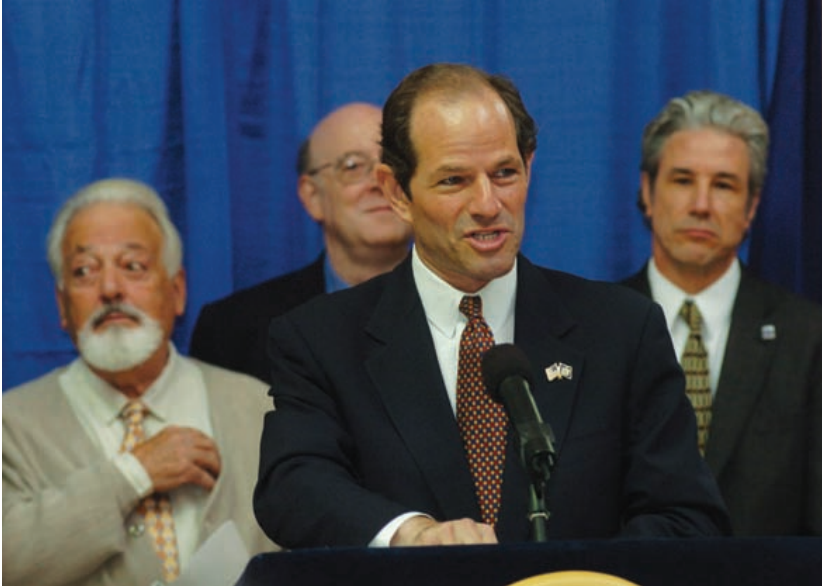Above: An interactive timeline of 15 years of Belleayre Resort review.
The staff of the New York Department of Environmental Conservation say that they have thoroughly vetted the environmental impact of the proposed Belleayre Resort on a Catskills mountaintop. But two families who weren’t part of the project’s marathon 15-year review process may sue the DEC if the agency allows the resort to go forward.
The Gould family, prominent Catskills philanthropists who are descendants of the 19th-century Catskills developer Jay Gould, own large amounts of land in Ulster and Delaware counties.
Ben Korman, a New York City real estate developer, and his wife have owned the Galli-Curci mansion, a historic property on Route 49A, since 2002.
Both families say that a new plan for the resort, created after Crossroads Ventures and its opponents hammered out a compromise in 2007, puts a large luxury spa hotel near their property without giving them a say in the process.
Crossroads Ventures’s plan to develop a five-star Highmount Spa Resort on the site of the defunct Highmount Ski area “essentially became a new project,” and therefore requires new review, a lawyer hired by the Gould family wrote in a legal document filed with the DEC in November.
After the DEC’s staff filed a motion in September saying that the agency’s review of the resort should be completed, both the Kormans and the Goulds filed formal petitions asking to be involved in the DEC’s review process. If the DEC rejects their petitions, they could sue the DEC itself in court, a move that would further delay plans for the resort.
Asked if a lawsuit against the DEC is in the cards, neither family ruled it out.
"Even given the past conduct of DEC in this matter, we remain hopeful that the [DEC] will follow its own regulations and grant our petition for party status, and then hear the substantial and significant issues we have raised,” said Melissa Gould in a written statement.
"That’s a hypothetical about an ongoing legal process, so it wouldn’t be appropriate for me to comment and prejudge the outcome,” said Ben Korman in an email. "We will consider our options once the decision is made."
The Kormans have sued the DEC before: In 2008, they and others filed a lawsuit against the DEC and others challenging the 2007 compromise. A judge dismissed that lawsuit.
Project history
The Belleayre Resort has been in the works since 1999, when Crossroads Ventures proposed a 573-acre resort with two luxury hotels and two golf courses on Belleyare Mountain, which straddles the border between Ulster and Delaware county.
A coalition of groups gathered to oppose the plan, and in 2007, then-Governor Eliot Spitzer brokered a deal known as the Agreement in Principle. In exchange for selling some of its land to the state, the resort would scale back, and plans for a luxury spa hotel would move to a new location at the former Highmount Ski area.
 Left: Gov. Eliot Spitzer announcing the Agreement in Principle in 2007. Photo via the Belleayre Resort website.
Left: Gov. Eliot Spitzer announcing the Agreement in Principle in 2007. Photo via the Belleayre Resort website.
At the time, an adjudication process to review potential issues with the project, presided over by the DEC's Office of Hearings and Mediation Services, was already underway. The 2007 agreement effectively put that adjudication process in limbo, suspending it until DEC staff could complete their own review of the project's environmental impact statements.
The DEC took seven years to complete its environmental review. In 2013, it issued a draft and accepted thousands of comments from the public. In July 2014, the agency released its final environmental impact statement for the project, which contained responses to all the comments.
That’s usually the last step in a project’s review. A DEC staff lawyer, Lawrence Weintraub, has issued two legal documents this fall advising the DEC to close the adjudication process, dismiss all remaining objections, and give the resort the green light.
But resort opponents—the Goulds, the Kormans, Friends of Catskill Park and the Catskill Heritage Alliance—are waging a highly technical legal battle with the DEC’s legal staff, arguing that more review is needed.
Adjudicatory hearing
All four groups filed motions this fall asking the DEC to reopen the resort’s case in a quasi-judicial procedure overseen by an administrative law judge at the DEC.
Kathy Nolan, the chair of the Catskill Heritage Alliance, said that the CHA never signed on to the 2007 agreement to allow a redesigned version of the resort to be built.
Therefore, the CHA's concerns about the size, scope and environmental impact of the project still deserve to be heard, she argues.
"It’s a little troubling to have this review taking place in the Office of Hearings and Mediation Services rather than in front of an administrative law judge where it started, and where we feel that our concerns can be fully and fairly considered,” Nolan said.
The Kormans and the Goulds have a different argument. Neither family was among the original coalition of resort opponents in 2007, and are not parties to the years of legal proceedings that have entwined the resort and its opponents. That’s because the original plan for the resort didn’t impact them, they say.

Above: A scale model of the proposed Highmount Spa Resort, part of the proposed Belleayre Resort. Two families who own property near the site of the spa are taking steps to legally oppose its construction. Photo by Julia Reischel.
"The project as it was proposed in 2004 would not have had much impact on our quality of life or property value, and we were willing to accept it,” wrote Ben Korman in an email.
But when the DEC approved the new Highmount Spa Resort as part of the resort’s revised plan in 2013, “it essentially became a new project,” wrote Julie Weisman, a lawyer at Carter Ledyard & Milburn, in the petition for party status submitted by the Goulds on Nov. 17.
“Obviously, when the first adjudicatory proceedings began in the early 2000s, the Goulds had no notice that the project would be re-located immediately adjacent to their homes and property,” she wrote.
Ben Korman feels the same way.
"Our property sits across the road from Highmount, which in the original project proposal would have undergone insignificant development,” he wrote in an email. "The [2007 agreement] changed that, and called for a resort which was so inappropriately huge (currently 629 rooms in total) and so badly sited it would have hurt not only us, but the whole community. Building all this requires major blasting a few hundred feet away from us that could damage our 90-year-old masonry house and contaminate our drinking water."
In November, both families filed legal documents requesting “party status," which would give them a formal say in the DEC’s review of the Belleayre resort.
They argue that the Highmount Spa Resort is a large construction project that that will cause major environmental damage to the area, including runoff and erosion, increased flooding in downstream communities, excessive noise, increased traffic on Route 49A and light pollution. They also argue that the resort will spoil the view of the ridgeline from surrounding roads and trails, and that it will damage the Galli-Curci mansion, which is on the New York and National Registers of Historic Places and is open to the public.
Ideally, said Melissa Gould, Crossroads Ventures would nix the high-end spa altogether, and limit the project to a single resort hotel, the Wildacres Resort, which is planned for the lower slopes of the mountain across from the Bellayre Mountain Ski Center.
“Stymied"
The Goulds and the Kormans have filed formal legal petitions for party status because the DEC isn’t addressing their concerns, they say.
Both families submitted public comments about the new Highmount development to the DEC, which responded to their concerns in the final version of the environmental impact statement this summer.
Neither family feels that the DEC’s response is enough.
"We have requested since 2012 to meet with DEC to express our concerns about the extensive Highmount development,” wrote Melissa Gould. “We did not have any opportunity to comment on the new project involving Highmount until the supplemental draft environmental impact statement (“SDEIS”) for the project was released to the public in the spring of 2013."
If the DEC doesn’t grant their petition to reopen the adjudicatory proceeding, Gould wrote, the DEC "essentially would be foreclosing our family’s right to be heard on these very important issues."
“If that request is granted, we will never have an opportunity to have our objections ruled on,” wrote Korman in an email. "That’s why we’ve filed for party status now."
Kathy Nolan, at the Catskill Heritage Alliance, supports the argument that the Goulds and the Kormans should be given a role in the resort’s review.
"It seems unfair that people who are now affected by the new configuration would not have the same opportunity to present their arguments that other parties have been given,” Nolan said.
DEC’s response
Weintraub, the DEC’s lawyer, is unconvinced by these arguments. On Dec. 8, he issued a testy memorandum in which he dismissed all continuing objections to the resort.
He appealed to “common sense,” writing:
“Surely, [the administrative law judge who put the adjudicatory procedure on hold] did not intend the next seven years to be spent revamping the project, drafting and reviewing an SDEIS, and Staff taking a hard look at whether it raised any substantive and significant issues, only to reconvene an issues conference, revisit party status, and adjudicate issues that Staff have determined are not substantive and significant."
That statement aside, the DEC has not formally responded to the Gould or Korman petitions to become parties in the case, except to say in an email to resort opponents on Nov. 19 that the agency would hold off on issuing a formal response until a future date.
Wendy Rosenbach, a spokesperson for the DEC, declined to give specifics about whether the DEC will allow the Goulds and the Kormans to become parties to the review process. She also declined to speculate about what the DEC would do if either family filed a lawsuit against it.
“It’s really too early to answer those questions,” she said.
In his Dec. 8 memo, Weintraub argues that issues like stormwater runoff, flooding, economic viability, light pollution and noise pollution have all been addressed, even for the new Highmount Spa Resort.
Since the new plans for the project have been unveiled, no one has "identified any substantive and significant issues,” he wrote.
Gary Gailes, a spokesman for Crossroads Ventures, agreed with Weintraub that the review of the project is complete. The DEC’s Dec. 8 motion “really speaks for itself,” he said.
“Logic would say that if all of these environmental issues that have been raised over the last decade have been mitigated,” Gailes said, "then these various other motions for party status would seem to become moot."
The Goulds disagree. Crossroads Ventures itself, by filing new studies and analyses after the end of the public comment period in 2013, has raised a host of substantive issues that haven’t been reviewed, Melissa Gould said
"If in fact the documents were complete and correct after all of those years of review cited by Mr. Weintraub, there should have been no need for the expenditure of time and money to produce these additional reports,” she wrote in her statement to the Watershed Post.
"We note that none of these new submittals by Crossroads were put out for public review and comment by DEC, and there are significant flaws in each."
For an interactive timeline of the Belleayre Resort's 15-year review process, see the top of this story.















